Abstract
Background
Mild moxibustion has been reported to effectively treat menopausal syndrome. This study investigated the efficacy and safety of using mild moxibustion at Shenshu for treating sub-health states in perimenopausal women.
Material/Methods
Sixty participants were randomly assigned to moxibustion and control groups. Participants in the moxibustion group received mild moxibustion at bilateral Shenshu (BL23) for 15 min daily. A course was 5 days, with 2 days between courses; treatment was conducted for 4 courses. Participants in the control group were given vitamin E soft capsules for 28 days. Physical condition, living conditions, emotional status, and energy status scores were assessed, and serum sex hormone levels measured.
Results
Mild moxibustion significantly improved physical condition, living conditions, and emotional status compared to the control group after treatment (P<0.05). Physical condition (P<0.01) and living conditions (P<0.05) improved significantly in post-menopausal women, while living conditions and emotional status were improved in pre-menopausal women (P<0.05). Serum estradiol level was significantly higher after moxibustion, especially for pre-menopausal women (P<0.01).
Conclusions
Mild moxibustion is safe and effective for treating sub-health state in pre-menopausal and post-menopausal women. A study with larger sample size and longer-term treatment is needed for further assessment of this topic.
MeSH Keywords: Mild Moxibustion, Pre- and Post-Menopausal Women, Sub-Health
Background
According to the Clinical Guidelines of Chinese Medicine on Sub-Health (China Association of Chinese Medicine), sub-health is characterized as a state between health and disease [1]. Because of dysregulated endocrine functions, peri-menopausal women often experience uncomfortable symptoms, including fatigue, insomnia, or joint pain. However, many women suffering from such symptoms do not meet the standards of menopausal syndrome in terms of clinical diagnosis, and we classify such cases as being in pre- or post-menopausal sub-health condition. In the past 2000 years, moxibustion has commonly been used as a clinical treatment method and for self-care at home among Chinese and other Asian people. It aims to excite Qi in channels to promote immunity levels and to prevent sickness and injuries caused by illness. The effectiveness of acupuncture against menopausal syndrome has been widely reported [2–5]; however, few studies have focused on the effectiveness of moxibustion for sub-health conditions of pre-menopausal or post-menopausal women. Therefore, we preformed the present randomized controlled clinical trial.
Material and Methods
Study design and ethics approval
Recruitment of subjects took place between June 2014 and July 2016. The study was approved by the Medical Ethics Committee of Nanjing University of Chinese Medicine and was completed in the Outpatient Department of the Xianlin Community Health Centre in Nanjing, China.
Participants were recruited through advertisements in the hospital. Volunteers that met all of the following criteria were included in the study: (1) women aged between 40 and 60 years [6]; (2) experienced repeated discomfort or significant loss of adaptive capacity for more than 3 months, but able to maintain normal work activities; (3) had no significant organic or mental disease [7]. All volunteers had the right to decide whether to participate or withdraw from the study at any time, and their decision did not affect their normal treatment procedures.
Sixty women that met the sub-health conditions were enrolled in the study and were randomized by a stochastic computer program to receive either moxibustion or Vitamin E treatment. All participants were blinded to the type of treatment method they received until they began their treatment. Overall, there were 28 cases in the moxibustion group and 27 cases in the control group, with 5 participants not completing the study (Figure 1). According to the history of menstruation, we judged whether they were pre-menopausal or post-menopausal: there were 12 pre-menopausal women and 16 post-menopausal women in the moxibustion group, and there were 11 pre-menopausal women and 16 post-menopausal women in the control group. The 2 groups were compared before the intervention and found to be similar (P>0.05; Table 1).
Figure 1.
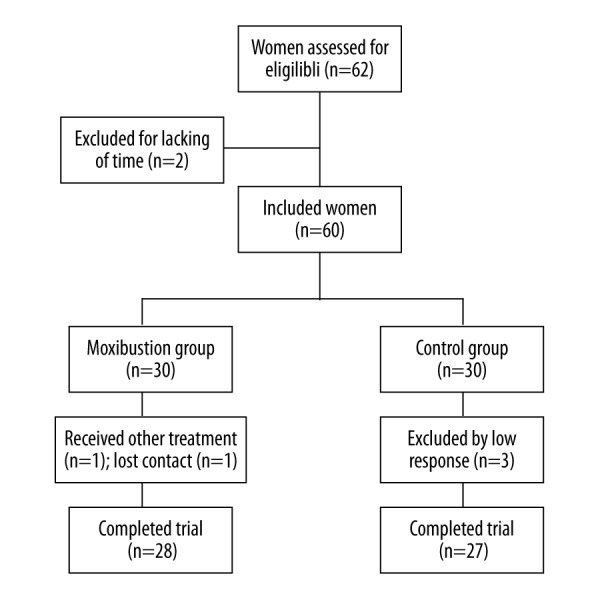
Flow chart of the trial.
Table 1.
The clinical characteristics of women in the 2 groups.
| Variable | Moxibustion group (n=28) | Control group (n=27) |
|---|---|---|
| Age (years) | 49.17±4.36 | 48.86±5.82 |
| Marital status (no.) | ||
| Married | 28 | 27 |
| Single | 0 | 0 |
| Menstrual history (no.) | ||
| Regular | 10 | 9 |
| Irregular | 2 | 2 |
| Amenorrhea | 16 | 16 |
| Menarche age (years) | 14±3.67 | 15±4.24 |
Treatments
Each participant received a total of 28 treatments. Participants in the moxibustion group received mild moxibustion at BL23 (Shenshu) bilaterally with a 25-g moxa stick (Suzhou Moxa Co., Suzhou, China) for 15 min per day, so that the participant felt comfortably warm. A course was 5 days, with 2 days between courses; treatment was conducted for 4 courses. Participants in the control group took 1 vitamin E capsule every night after their main meal for 28 days.
Assessment
Outcomes consisted of a sub-health questionnaire and sex hormone levels assessment. Following the epidemiological survey of basic syndromes of Traditional Chinese Medicine (TCM) in a sub-healthy population, the physical condition (e.g., dizziness, dry throat, sore eyes, mouth ulcers, and appetite), living conditions (e.g., sleep conditions, defecation, urination, and work ability), emotional status (e.g., confidence, whether it is easy to get angry, attitude about life), and energy status (e.g., work efficiency, energy outside work, daily life ability) of participants were observed, recorded, and rated on a scale of 1 to 5 using a questionnaire. To assess physiological characteristics of peri-menopausal women, the frequency of hot flashes (additional assessment 1) was added in the section addressing physical conditions in the questionnaire. Higher scores indicate more severe symptoms (i.e., worse physical condition). For the emotional and energy status, lower scores indicated more severe symptoms. Sex hormone assessment consisted of blood serum levels of follicle-stimulating hormone (FSH), luteinizing hormone (LH), estradiol (E2), testosterone (T), progesterone (P), and prolactin (PBL). Venous blood was extracted 1 day before treatment began and 1 day after treatments finished if the participant was menopausal, and in the first 2 to 5 days of the menstrual cycle immediately preceding and following treatment in pre-menopausal participants.
Statistical analysis
The required sample size was estimated based on evidence from the relevant literature [8] and calculated by . The power and a two-sided significance level were set as 80% and 5%, respectively. Based on this, at least 60 patients (30 per treatment group) was the target sample size (assuming a 20% dropout rate).
All collected data are expressed in terms of the mean value ± standard deviation in each group. SPSS 23.0 software was used in the analyses and a P value <0.05 was considered a significant difference. Pre-menopausal and post-menopausal subjects were compared using independent two-sample t tests. To test effects of treatment, before- and after-treatment measures within each group were compared using the paired t test.
Results
Outcomes
Overall physical condition and living conditions significantly improved in the moxibustion group compared with the control group (P<0.01; Figure 2). However, as shown in Figure 3, physical condition, living conditions, and emotional status were improved in pre-menopausal women (P<0.05), while only physical condition and living conditions improved significantly in post-menopausal women (P<0.01). Independent two-sample t tests further indicated that physical condition, living conditions (P<0.05), and emotional status (P<0.01) of post-menopausal women were worse than those of pre-menopausal ones.
Figure 2.
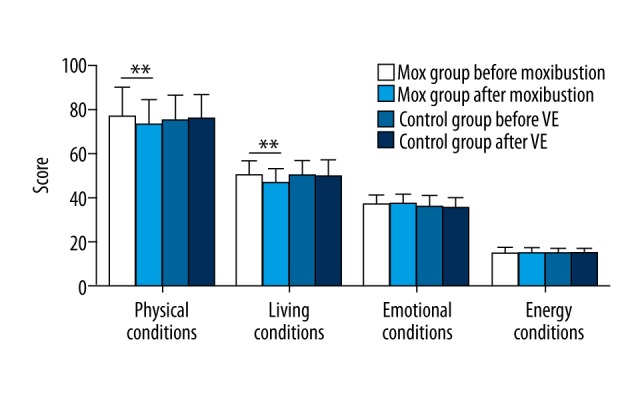
Comparison of the scores between the mox group and the control group (mean ±SD). ** P<0.01.
Figure 3.
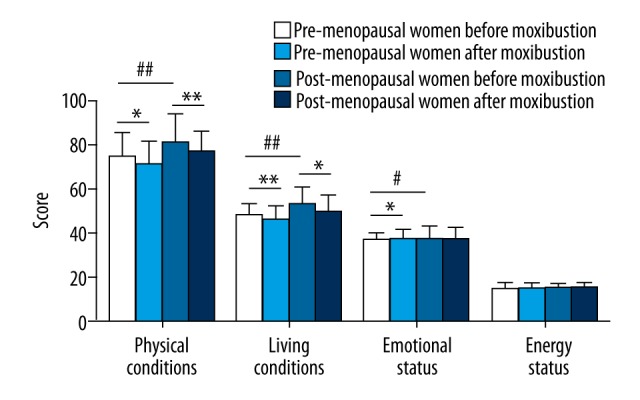
Comparison of the scores between the pre-menopausal women and post-menopausal women in the mox group (mean ±SD). *, # P<0.05; ** ## P<0.01.
Overall, the moxibustion group had significantly higher E2 levels (P<0.01) than the control group after treatment (Figure 4), and the moxibustion group E2 levels increased significantly with treatment in pre-menopausal women (P<0.01, Figure 5). In comparisons of pre- and post-menopausal women, progesterone, E2 levels (P<0.01; Figures 5, 6), and PBL levels (P<0.05; Figure 5) were significantly higher in pre-menopausal women, whereas LH and FSH levels were significantly higher for post-menopausal women (P<0.01; Figure 5). There were no significant differences in testosterone levels.
Figure 4.
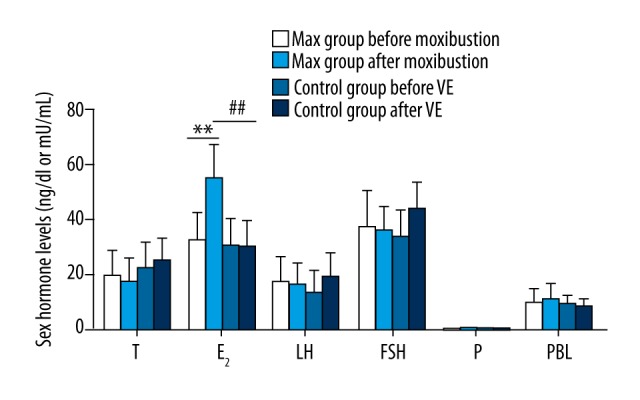
Comparison of the serum sex hormone levels between the mox group and the control group (mean ±SD). **, ## P<0.01.
Figure 5.
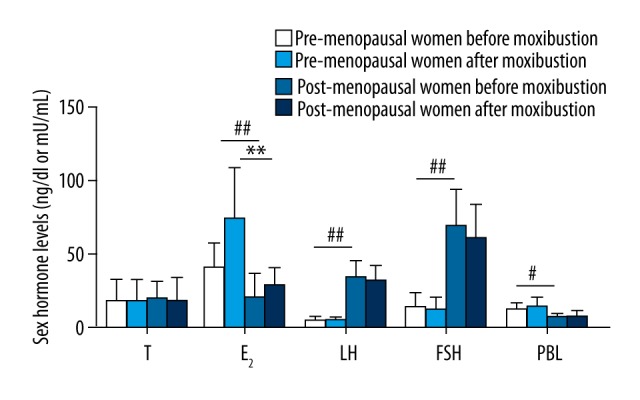
Comparison of the serum sex hormone levels between the pre-menopausal women and the post-menopausal women in the mox group (mean ±SD). # P<0.05, **, ## P<0.01.
Figure 6.
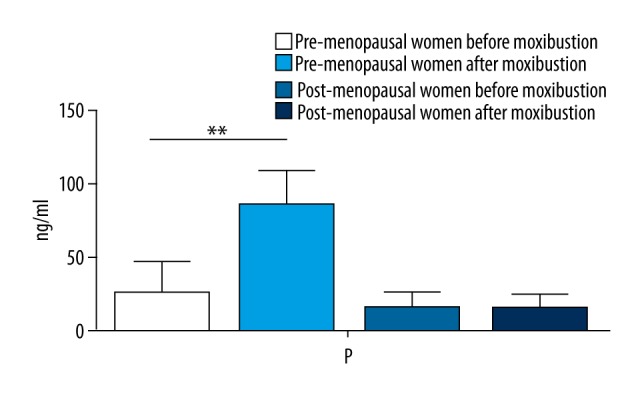
Comparison of the progesterone levels between the pre-menopausal women and post-menopausal women in the mox group (mean ±SD). ** P<0.01.
Safety
No serious adverse incidents were reported. One participant reported feeling thirsty each time after the moxibustion treatment and was advised to drink more water. Most patients regarded moxibustion as a safe treatment procedure and wanted to purchase more moxa pillars for self-moxibustion at home.
Discussion
In Chinese medicine theory, the kidney-qi gradually declines as women go through menopause [9]. During this process, the Tiangui dries up and the Chong and Ren meridians become unbalanced, creating deficiencies in the Qi and blood. As a result, reproductive ability is reduced or disappears. The Shenshu point (BL-23) is the gathering place of the kidney essence and can tonify the kidney [10]. Therefore, we selected Shenshu (BL-23) as the intervention method for sub-healthy perimenopausal women. The moxibustion treatment can arouse body potentials; it can also arouse and regulate intrinsic resistance against diseases. During these processes, an irritation response can mobilize intrinsic prevention mechanisms, which are part of the defensive reflex [11]. Over the past decade, moxibustion has been reported to effectively alleviate the symptoms of menopause syndrome. However, there is little evidence on the efficacy of moxibustion for sub-health conditions of pre- or post-menopausal women.
In this study, we found that the physical and living conditions of post-menopausal women were worse than those of pre-menopausal women. However, their emotional status and energy status were better; one possible explanation is that post-menopausal women receive less mental pressure from work and family. Moxibustion was effective in improving physical and living conditions of perimenopausal women, and especially post-menopausal women (P<0.05), and for improving the living condition and emotional status of pre-menopausal women (P<0.05).
Estrogen can help maintain normal functioning of the ovaries and uterus and previous studies using animal models suggest that rat uterine E2 levels decrease with age [12], which may be associated with ovarian degradation. Studies have shown that the moxibustion treatment increases estrogen levels, the expression level of its receptor in female sexual organs and can increase the rate of combination between estrogen and its receptors [13]. This process effectively mediates the biological effects of estrogen and adjusts the endocrine system.
In our experiment, E2 and PBL levels were significantly decreased in post-menopausal women (P<0.01 and P<0.05, respectively) compared to pre-menopausal women before treatment, while FSH and LH levels were significantly increased (P<0.01). Moxibustion treatment at the Shenshu point (BL-23) significantly increased E2 levels of pre-menopausal women (P<0.01), but had no obvious effect on post-menopausal women. This may be due to the imbalance in hormone levels in pre-menopausal subjects, and the fact that their endocrine systems can be adjusted by moxibustion treatment, which rebalances hormone levels to a normal status. In women with decreased estrogen levels, ovarian degeneration, and decreased endocrine regulation ability during menopause, the effect of moxibustion treatment is not obvious. Moxibustion treatment at the Shenshu point (BL-23) can reduce the serum LH and FSH levels and increase progesterone and PBL levels; however, such changes were not observed in this study. This may be because the duration of this study was only 1 month; future research extending the research period and including more sex hormone indexes is necessary for a more complete understanding.
Although our 28-day treatment may not have been sufficiently long to generate some sex hormones changes, we did see physical condition, living conditions, and emotional status of women in the moxibustion treatment group improve significantly (P<0.05) compared to the control group. We plan to further investigate the effect of moxibustion over a longer period (at least 3 months) and include more indicators (e.g., immunity, bone, and joint functions) in our next clinical study.
Conclusions
Moxibustion treatment at the Shenshu point (BL-23) can effectively improve perimenopausal sub-health conditions. This effect is especially evident among post-menopausal subjects with regard to their physical and living conditions, and pre-menopausal women with regard to their living conditions and emotional status. No obvious adverse effects of moxibustion treatment were noted in our study. This study helps to characterize a clinical basis for the prevention and treatment of sub-health conditions with moxibustion treatments.
Footnotes
Source of support: This study was supported by grants from the National Natural Science Foundation of China (No. 81774408), the Science and Technology Project of Jiangsu Provincial Administration of Traditional Chinese Medicine in China (No. YB2017005), and the Nanjing University of Chinese Medicine Natural Science Foundation Project for Young Scholars of China (No. 13XZR15)
References
- 1.China Association of Chinese Medicine. Clinical Guideline of Chinese Medicine for Sub-health State. Beijing: China press of traditional Chinese medicine; 2006. p. 12. [Google Scholar]
- 2.Bao CL, Cheng WY, Wang WD. [Observations on the therapeutic effect of Lu’s warm needling on perimenopausal syndrome]. Shanghai J Acu-mox. 2015;34(5):435–37. [in Chinese] [Google Scholar]
- 3.Zheng LF, Jing YB. [Clinical analysis on combined acupuncture and ginger-partitioned moxibustion for perimenopause syndrome]. Shanghai J Acu-mox. 2011;30(10):673–74. [in Chinese] [Google Scholar]
- 4.Yang XH, Pi Y. [Acupuncture and Moxibustion in the intervention for prevention early onset of 50 cases of climacteric syndrome]. Modern Traditional Chinese Medicine. 2012;32(5):48–49. [in Chinese] [Google Scholar]
- 5.Zhou XR. [Syndrome observation and nursing of therapy for menopause 70 cases of acupuncture plus auricular point]. CJGMCM. 2015;30(1):112–13. [in Chinese] [Google Scholar]
- 6.Yu Q. Study of menopause. Beijing: People’s medical publishing house; 2013. p. 69. [Google Scholar]
- 7.Liu BY, He LY, Xie YM, et al. [The development of questionnaire on sub-health state basic pattern characteristics of traditional Chinese medicine]. Chin J Basic Med Tradit Chin Med. 2004;10(9):23–28. [in Chinese] [Google Scholar]
- 8.Lu H, ling H, Jun Z, et al. [Effect of moxibustion sanyinjiao and guanyuan on peripheral syndrome sex hormone levels]. Journal of Yunnan University of Traditional Chinese Medicine. 2014;37(3):36–38. [in Chinese] [Google Scholar]
- 9.Plain Question. Beijing: China medical science press; 2011. p. 2. [Google Scholar]
- 10.Dou C. Bianque Heart Book. Beijing: China medical science press; 2011. p. 11. [Google Scholar]
- 11.Liang P, Mi L, Chang XR, et al. Effects of pre-moxibustion at Zusanli (ST36) on heat shock protein 70 expression in rats with gastric mucosal lesions after neurotomy. Neural Regen Res. 2012;7(30):2370–76. doi: 10.3969/j.issn.1673-5374.2012.30.007. [DOI] [PMC free article] [PubMed] [Google Scholar]
- 12.Sun ZF, Li XH, Mo J, et al. [Effect of preventive moxibustion at guanyuan point on endometrial heat shock protein (HSP) 70, SOD and E2 Level of normal 12-month-old menopausal rats]. J Beijing Univ Tradit Chin Med. 2011;34(11):759–62. [in Chinese] [Google Scholar]
- 13.He YW, Li XH, Zhai JH, et al. [Effect of preventive acupuncture and moxibustion on endocrine of ovariectomized rats]. Chin Archives Tradit Chin Med. 2008;26(9):1918–20. [in Chinese] [Google Scholar]


